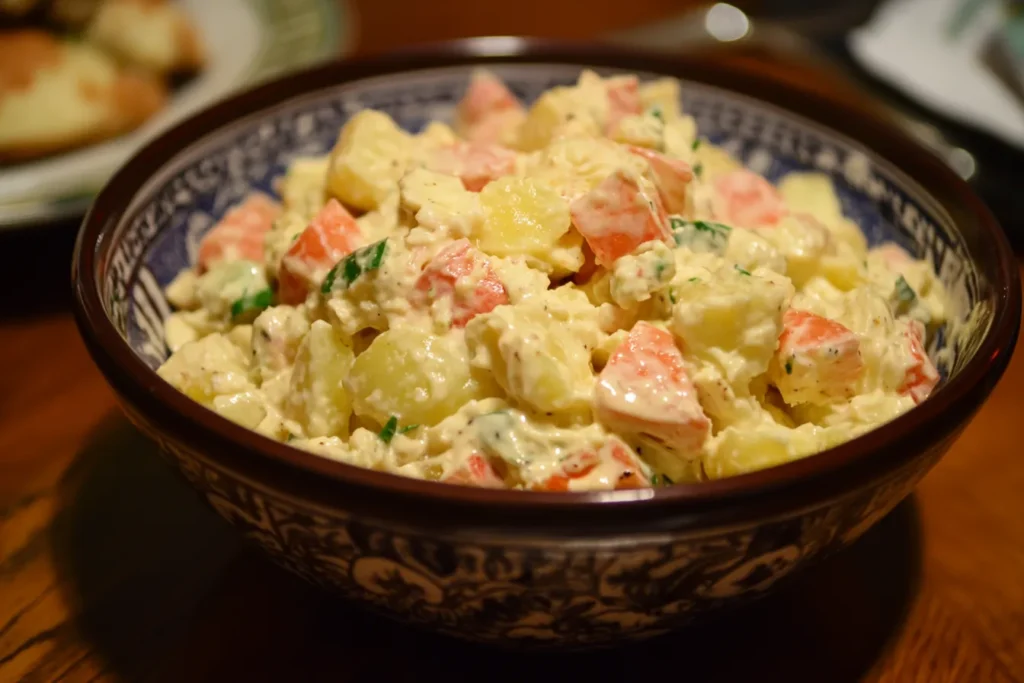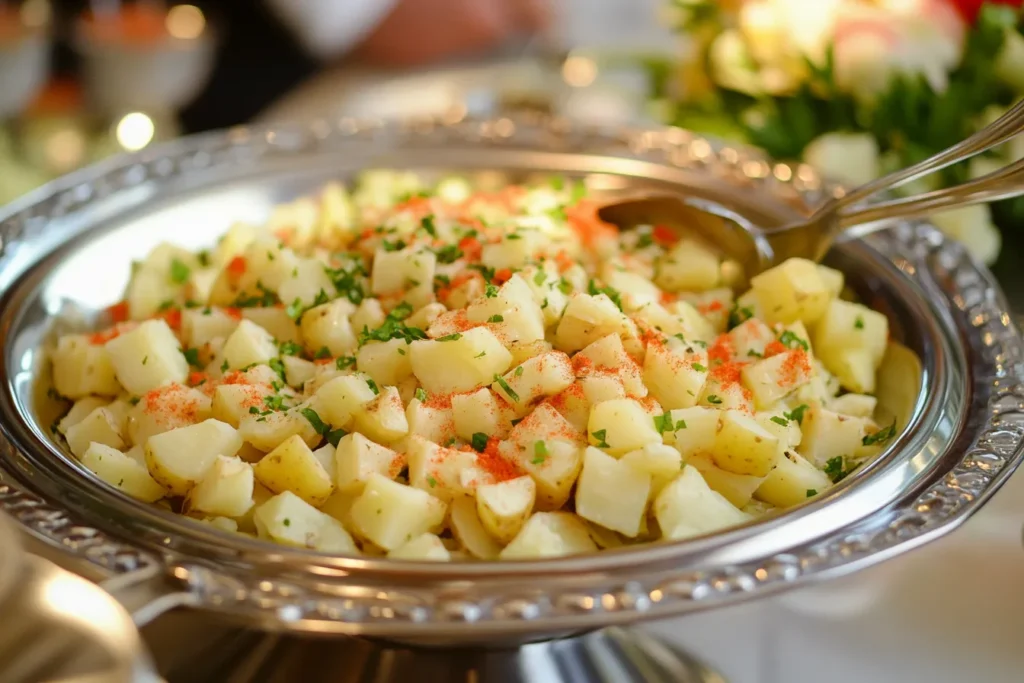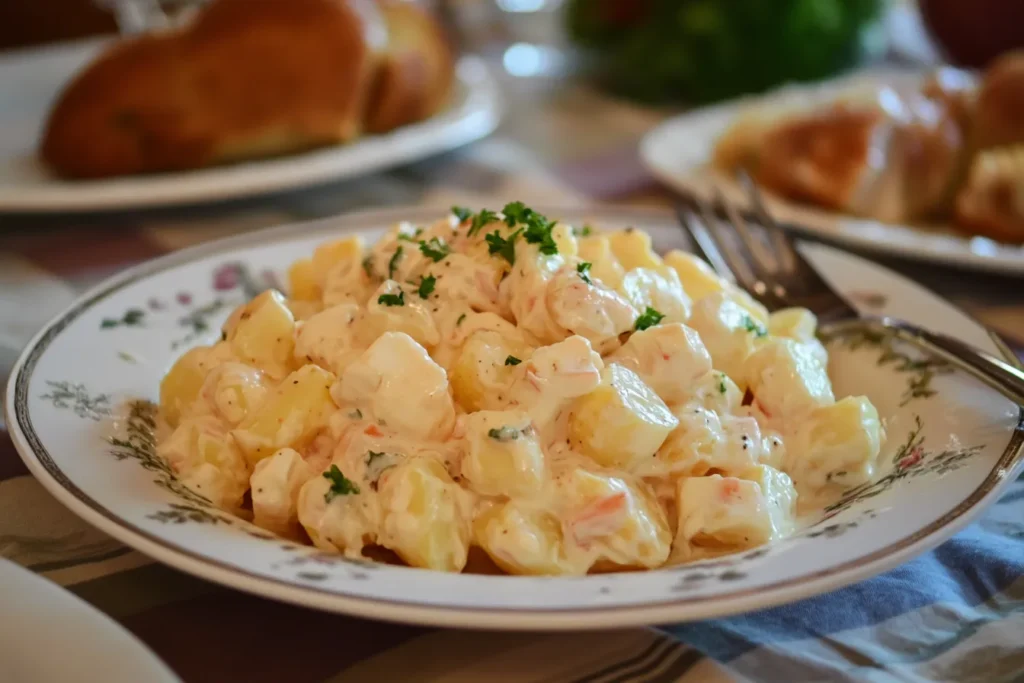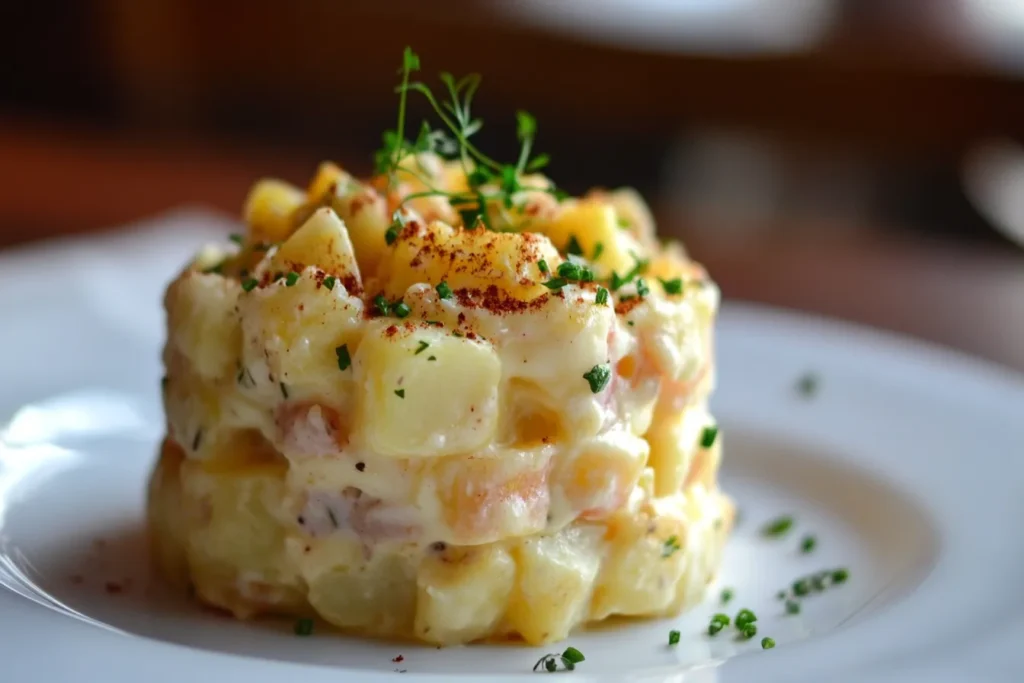Have you ever taken a bite of potato salad that instantly brought back memories of family picnics and summer barbecues? That’s the magic of a classic potato salad—simple, creamy, and bursting with familiar flavors that feel like home. But here’s the thing: not all potato salads hit the mark. Whether it’s the perfect balance of tangy dressing, tender potatoes, or just the right crunch from veggies, nailing this timeless dish can solve all your potluck or dinner dilemmas. I’ve been there too, searching for the recipe that gets it just right, and let me tell you—this one is a keeper. Let’s dive into what makes this classic potato salad an all-time favorite and how you can make it for your next gathering!
List Of Contents
What is Classic Potato Salad?
Potato salad is a timeless dish that has undeniably cemented its place as a staple in family gatherings, potlucks, and barbecues. Not only is it known for its creamy texture and savory taste, but it also skillfully brings together tender potatoes, a rich dressing, and complementary ingredients such as celery, onion, and pickles. Moreover, its versatility makes it a crowd-pleaser at any event, effortlessly adapting to various preferences and flavors. Whether served cold or at room temperature, classic potato salad is a comfort food with a nostalgic charm. Check out more recipes here.
History of Potato Salad
The origins of potato salad can be traced back to Europe, where, during the late 16th century, potatoes were first introduced. Over time, this humble ingredient gradually gained popularity, eventually inspiring the creation of the dish we know and love today. German immigrants brought their warm vinegar-based potato salad recipes to the United States in the 19th century, which later evolved into the cold, mayonnaise-dressed version Americans adore today. Across cultures, potato salad has adapted to local tastes, making it a globally recognized dish.
- In Germany, potato salad often features a tangy vinegar and bacon-based dressing.
- In Japan, a creamier version includes mashed potatoes, carrots, and cucumbers.
- In the Southern U.S., mustard and relish are common additions, creating a zesty twist.
Types of Potato Salad

Potato salad isn’t a one-size-fits-all dish. It spans a spectrum of flavors and textures:
- German Potato Salad: Warm, tangy, and made with vinegar and bacon.
- American Potato Salad: Cold, creamy, and often includes mayonnaise, mustard, and eggs.
- French Potato Salad: Tossed with olive oil, vinegar, and fresh herbs.
- Asian Potato Salad: Slightly sweet, featuring Japanese mayonnaise and crunchy vegetables.
These variations showcase the versatility of potato salad, ensuring there’s a version to suit every palate. Check out more recipes here.
What Makes a Potato Salad “Classic”?
A classic potato salad adheres to a few essential rules, which have been refined over generations. To begin with, its hallmark features include a creamy dressing, evenly cooked potatoes, and a carefully balanced mix of flavors. Furthermore, here’s what you can typically expect in a traditional recipe:
- Potatoes: Waxier varieties like Yukon Golds or red potatoes for structure.
- Dressing: Typically mayonnaise-based, with mustard for a tangy kick.
- Add-ins: Chopped celery, onions, and pickles for crunch and flavor.
- Seasoning: Salt, pepper, and a touch of paprika for garnish.
Key Ingredients of Classic Potato Salad
The core ingredients, though simple, are absolutely integral to achieving its iconic taste. Specifically, these elements come together to create the perfect harmony of flavor and texture:
- Potatoes: Waxier types hold their shape and soak up dressing without becoming mushy.
- Mayonnaise: The creamy backbone of the dressing.
- Mustard: Adds tanginess and depth.
- Celery and Onions: Provide crunch and freshness.
- Hard-Boiled Eggs: A classic addition for richness.
- Pickles or Relish: Contribute a slight tangy sweetness.
Why Classic Potato Salad Remains a Favorite
Potato salad has endured as a beloved side dish for several reasons:
- Simplicity: With just a few basic ingredients, it’s easy to prepare.
- Customizability: Endless opportunities for tweaks and personal touches.
- Versatility: Pairs perfectly with grilled meats, sandwiches, or even on its own.
- Comfort Factor: Nostalgia and familiarity make it a crowd-pleaser.
Nutritional Overview
While classic potato salad is delicious, it’s worth noting its nutritional aspects:
- Calories: Often high due to the mayonnaise dressing.
- Carbohydrates: A significant source from the potatoes.
- Fats: Predominantly from mayonnaise, with room for lighter alternatives.
- Protein: Additions like eggs or bacon can boost protein content.
For a healthier version, consider substituting Greek yogurt or low-fat mayonnaise for the dressing. Check out more recipes here.
Regional Variations in the Recipe
Every region has its unique take on classic potato salad:
- Southern U.S.: A sweeter profile with relish and mustard.
- Midwestern U.S.: Heavy on mayonnaise and eggs.
- German Influence: Warm potato salads with a vinegar base.
- Asian-Inspired Variations: Sweeter dressings with crunchy vegetables.
Must-Have Ingredients in Classic Versions
While the recipe allows for experimentation, the following ingredients are non-negotiable for a classic potato salad:
- Potatoes: They are the foundation.
- Mayonnaise and Mustard: Essential for the dressing.
- Seasonings: Salt, pepper, and paprika.
Classic Potato Salad vs. Modern Twists

The classic recipe relies on simplicity, while modern versions introduce creative spins like:
- Avocado-Based Dressing: For a creamy yet healthier option.
- Spicy Variants: Featuring jalapeños or sriracha.
- Diverse Mix-Ins: Such as roasted red peppers or feta cheese.
Classic potato salad remains the gold standard for its time-tested flavor, but modern adaptations add exciting new dimensions. Check out more recipes here.
How to Make Classic Potato Salad at Home
Creating a classic potato salad is just as enjoyable as savoring the final dish. With this step-by-step guide, you can confidently ensure that your potato salad turns out flavorful, creamy, and crowd-pleasing every time. Moreover, following these instructions will help you achieve the perfect balance of taste and texture.
Choosing the Right Potatoes
Creating a classic potato salad is not only a delightful experience but also a rewarding culinary journey. To begin with, this step-by-step guide will ensure your dish is consistently flavorful, creamy, and crowd-pleasing. Furthermore, by carefully following these instructions, you can achieve the perfect balance of taste and texture. In addition, every step is designed to simplify the process while enhancing the overall result. Ultimately, with patience and attention to detail, you’ll create a potato salad that is sure to impress at any gathering.
- Why Yukon Gold?: Creamy texture and natural buttery flavor.
- Why Red Potatoes?: Firm structure with a hint of sweetness.
Avoid starchy potatoes like Russets for this recipe, as they tend to break apart and create a mashed consistency.
Boiling Potatoes to Perfection
The first step to a great potato salad is properly cooked potatoes. Here’s how to achieve the perfect texture:
- Peel or Leave the Skins: This is a personal choice—skins add texture, while peeling provides a smoother finish.
- Cut into Even Pieces: Uniform pieces ensure even cooking.
- Start with Cold Water: Place potatoes in cold water to prevent the outside from overcooking.
- Add Salt to Water: Season the water generously for flavorful potatoes.
- Simmer, Don’t Boil: Cook at a gentle simmer to maintain their shape.
- Check for Doneness: Potatoes are ready when a fork slides in easily, but they’re still firm.
Drain the potatoes thoroughly and let them cool completely before mixing them with other ingredients to avoid a watery salad.
Prepping Ingredients
While the potatoes cool, prepare the other components of your salad:
- Chop Celery and Onions: Aim for small, uniform pieces to distribute flavor evenly.
- Boil and Slice Eggs: For added protein and richness.
- Dice Pickles or Use Relish: A touch of acidity balances the creamy dressing.
Efficient preparation ensures all elements are ready for assembly when the potatoes are cooled.
Essential Dressing Ingredients
The dressing is undoubtedly the heart of a classic potato salad, serving as the element that ties all the ingredients together. Specifically, it combines creamy, tangy, and savory flavors to create a harmonious blend that elevates the dish. Moreover, the balance of these flavors is crucial in ensuring the potato salad remains both rich and refreshing.
- Mayonnaise: Choose a high-quality brand for the best flavor.
- Mustard: Yellow or Dijon mustard works well, depending on your preference.
- Vinegar: Adds brightness and enhances flavors.
- Seasonings: Salt, pepper, and optionally, garlic powder or paprika.
Achieving the Perfect Dressing Consistency
Consistency matters. The dressing should coat the potatoes evenly without overwhelming them.
- Whisk together mayonnaise, mustard, vinegar, and seasonings in a separate bowl.
- Adjust thickness by adding a small splash of pickle juice or milk if necessary.
- Taste and tweak the balance of salt, tang, and sweetness to your liking.
Mixing Ingredients Properly
To ensure the flavors are evenly distributed:
- Place cooled potatoes in a large bowl.
- Add celery, onions, eggs, and pickles or relish.
- Pour the dressing over the mixture.
- Gently Fold: Use a spatula to mix without breaking the potatoes.
Adding Crunchy Elements
Crunchy ingredients bring texture to your salad. Consider adding:
- Celery: Classic choice for a fresh bite.
- Pickles: Sweet or dill pickles provide a sharp contrast.
- Red Onions: For a mild crunch with a pop of color.
Ensure all crunchy additions are chopped finely to avoid overpowering the dish.
Refrigeration Time
Patience pays off when it comes to potato salad. Refrigerate for at least 2 hours before serving. This allows the flavors to meld and the dressing to soak into the potatoes, enhancing the overall taste.
- Pro Tip: Cover the bowl with plastic wrap to prevent the salad from absorbing other fridge odors.
Presentation Tips
A visually appealing potato salad is more inviting. Here are some presentation ideas:
- Garnish with Herbs: Sprinkle fresh parsley, dill, or chives for a vibrant touch.
- Paprika Dusting: A light sprinkle of paprika adds color and a hint of spice.
- Serve in a Decorative Bowl: A bright or patterned bowl enhances the presentation.
Key Tips for Perfect Potato Salad Every Time
- Season Generously: Potatoes absorb salt and seasonings well—don’t hold back.
- Avoid Overmixing: Gently fold the ingredients to keep potatoes intact.
- Customize for Flavor: Taste as you go and adjust seasoning to balance creaminess, tang, and sweetness.
Customizing Your Potato Salad

While the classic potato salad recipe holds timeless appeal, personalizing it to suit your taste preferences can take it to the next level. From adding proteins to experimenting with mix-ins, here’s how to make the dish uniquely yours.
- Adjust Texture: For a chunkier salad, cut potatoes into larger pieces. For a smoother version, mash some of the potatoes while mixing.
- Play with Flavors: Enhance the dressing with a splash of lemon juice or a dash of hot sauce.
- Experiment with Dressing Base: Swap mayonnaise for sour cream, Greek yogurt, or an olive oil vinaigrette.
Adding Protein Options
Incorporating protein-rich ingredients not only makes your potato salad more filling but also enhances its versatility for various occasions. For example, adding ingredients like hard-boiled eggs, grilled chicken, or crispy bacon can provide a satisfying boost of flavor and texture. Additionally, options such as chickpeas, tofu, or shredded cheese offer great alternatives for diverse dietary preferences.
- Hard-Boiled Eggs: A staple in classic recipes, eggs add creaminess and richness.
- Bacon: Crispy, crumbled bacon lends a smoky, salty flavor.
- Ham or Diced Chicken: These meats add heartiness, transforming the salad into a complete meal.
- Seafood: Add shrimp, crab, or smoked salmon for a luxurious twist.
Vegetarian and Vegan Variations
For those with dietary preferences, it’s easy to create a plant-based potato salad without sacrificing flavor:
- Vegan Mayonnaise: Use a plant-based mayo alternative.
- Silken Tofu Dressing: Blend silken tofu with lemon juice, mustard, and olive oil for a creamy dressing.
- Veggie Additions: Boost nutrition and flavor with roasted red peppers, cherry tomatoes, or steamed green beans.
Adding Herbs and Spices
Fresh herbs and spices have the power to completely transform a simple potato salad into a vibrant and flavorful dish. For instance, incorporating fresh parsley, dill, or chives can add a burst of freshness, while spices like paprika, mustard powder, or black pepper enhance depth and complexity. Furthermore, experimenting with combinations of herbs and spices allows you to tailor the dish to suit your personal taste or the theme of any gathering.
- Dill: A classic choice for its bright, tangy flavor.
- Parsley: Adds freshness and balances rich ingredients.
- Chives or Scallions: For a mild onion flavor.
- Paprika or Smoked Paprika: A sprinkle on top enhances the dish’s appearance and flavor.
For a bolder twist, consider adding ground cumin, coriander, or a touch of curry powder.
Creative Mix-Ins
Why stick to tradition when you can experiment with exciting additions? Some creative mix-ins to try include:
- Cheese: Crumbled feta or shredded cheddar for a creamy, tangy element.
- Olives: Sliced green or black olives add a Mediterranean touch.
- Pickled Vegetables: Such as capers or pickled red onions for extra zing.
- Nuts and Seeds: Toasted sunflower seeds or chopped almonds for crunch.
Pairing Potato Salad with Other Dishes
Potato salad shines as a versatile side dish that pairs well with various mains:
- Grilled Meats: Burgers, hot dogs, chicken, or ribs complement the creamy salad.
- Barbecue Favorites: Serve alongside smoked brisket or pulled pork.
- Vegetarian Options: Pair with grilled vegetables, veggie burgers, or lentil-based dishes.
- Refreshing Drinks: Iced tea, lemonade, or light white wine complete the meal.
Seasonal Variations
Adapting potato salad to the season can keep it fresh and exciting:
- Summer BBQs: Add grilled corn, avocado, or fresh basil for a light, summery vibe.
- Winter Potlucks: Incorporate roasted sweet potatoes, caramelized onions, or hearty mustard for a warming twist.
- Holiday Table: Sprinkle with pomegranate seeds or toasted nuts for festive flair.
Storage and Shelf Life
Potato salad is best enjoyed fresh, but proper storage can extend its life:
- Refrigeration: Keep the potato salad in a sealed container and refrigerate it for up to 3–4 days.
- Avoid Freezing: The texture of potatoes and the creamy dressing don’t hold up well when frozen.
- Serve Safely: If serving at outdoor events, keep it chilled over ice to prevent spoilage.
Common Mistakes to Avoid

Even experienced cooks may occasionally face challenges when preparing potato salad. Here are some pitfalls to watch out for:
- Overcooking Potatoes: Results in a mushy texture.
- Under seasoning: Potatoes absorb seasoning, so don’t be shy with salt and spices.
- Skipping the Resting Period: Flavors need time to meld for optimal taste.
- Using Watery Ingredients: Drain pickles and celery thoroughly to prevent a soggy salad.
Crowd-Pleasing Potato Salad
Adjusting your potato salad recipe to serve larger gatherings is straightforward and easy to manage:
- Plan Portions: Estimate ½ cup per person as a side dish.
- Use a Larger Mixing Bowl: To ensure even distribution of ingredients.
- Double the Dressing: Always prepare extra dressing to adjust consistency as needed.
Pro Tip: Offer a topping bar with bacon bits, fresh herbs, and extra dressing for guests to customize their servings.
Fun Facts About Potato Salad
- The earliest potato salad recipes date back to 16th-century Europe.
- In Germany, potato salad is a traditional Christmas Eve dish.
- Potato salad gained popularity in the U.S. during the 19th century with German immigrants.
- It’s a go-to side dish at Fourth of July celebrations.
- Mayonnaise-based potato Salads gained widespread popularity in the mid-20th century, largely due to the increased availability of commercial mayonnaise.
- In Japan, potato salad is commonly prepared using mashed potatoes, resulting in a smoother and creamier texture.
- Southern-style potato salad often includes sweet pickles and mustard for a tangy twist.
- The largest potato salad ever made set a world record, weighing an astonishing 3,000 pounds!
- Some cultures incorporate fruits such as apples or raisins into their versions of potato salad, adding a touch of sweetness and unique flavor.
- Potato salad pairs well with nearly any grilled dish, making it a universal barbecue favorite.
FAQs
- How can I make potato salad ahead of time?
- Prepare the potato salad a day in advance to let the flavors meld together, and store it in the refrigerator to keep it fresh.
- Can I add fruits to potato salad?
- Yes, adding diced apples or raisins provides a delightful sweet contrast to the savory flavors of potato salad.
- What’s a good alternative to celery?
- Try diced fennel or green bell peppers for a similar crunch.
- How do I keep my potato salad from drying out?
- Set aside some additional dressing to mix in just before serving to keep the potato salad moist and flavorful.
- Can I add pasta to potato salad?
- Yes, pasta can make it a heartier dish, similar to a macaroni-potato salad hybrid.
- Is it okay to leave potato salad out at a party?
- Only for 2 hours max; keep it chilled over ice for longer events.
- How can I make it spicier?
- Include diced jalapeños, a pinch of cayenne pepper, or a splash of hot sauce to give your potato salad a spicy kick.
- What’s the best vinegar to use?
- White wine vinegar or apple cider vinegar are excellent choices for tanginess.
- Can I make it without eggs?
- Yes, you can skip the eggs to create a lighter version or to accommodate dietary restrictions.
- What’s the easiest way to scale up the recipe?
- Simply increase the quantities of ingredients proportionally, doubling or tripling them while keeping the ratios consistent.
- What’s the best potato for potato salad?
- Waxy potatoes like Yukon Golds or red potatoes are ideal.
- Can I freeze potato salad?
- Freezing is not recommended due to the mayonnaise dressing.
- Is potato salad gluten-free?
- Most recipes are naturally gluten-free, but check all ingredients for cross-contamination.
- How do I avoid watery potato salad?
- Drain the potatoes thoroughly and let them cool before mixing.
- Can I skip the mayonnaise?
- Yes, you can use Greek yogurt or a vinaigrette as a substitute for a lighter alternative.
- What’s the secret to flavorful potato salad?
- Season the potatoes with salt while boiling and balance the dressing’s acidity.
